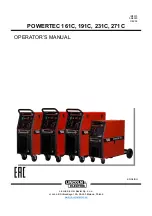
© Welding Industries Malaysia Sdn. Bhd. reserves all rights even in the event of industrial property rights. We reserve all rights of disposal
such as copying and passing on to third parties. Specification may vary from country to country.
V1.1.07
10
6-0 WELDING TECHNIQUES
6-1 Setting of the Machine
The setting of a MIG S Series welding machine demands some practice from the welder, the
machine having two control points that have to conform. These two are the wire feed speed
and the welding voltage. The welding current is determined by the wire feed speed, and it
should correspond to the work piece. The current will increase wire speed, resulting in a
shorter arc. Less wire speed will reduce the current and lengthen the arc. Increasing the
welding voltage hardly alters the current intensity, but lengthens the arc. By decreasing the
voltage a shorter arc is obtained with little change in current intensity.
When using CO2 as shielding gas, increase the voltage by about 5 volts per 100 Amp.
When changing the wire diameters, different control settings are required. A thinner wire
needs more speed to acquire the same current strength. A satisfactory weld cannot be
obtained if extreme values are exceeded.
If the feed speed is too high for the welding voltage, blockage will occur in the torch as the
wire dips into the molten pool and does not melt. Welding in these conditions normally gives
faults due to lack of fusion. If, however, the welding voltage is too high, large drops will form
on the end of the wire, causing spatter. The correct setting of voltage and speed can be seen
in an even and calm arc.
6-2 Influence of the Welding Position
The position of the torch and the work piece is important for quality and appearance of the
seam.
The diagrams on the next page show some of the many possibilities and indicate
schematically the importance of these positions. In practice one of course uses all
combinations of welding positions, torch directions and positions of the work piece.
Together with the figures, the diagram may help when an estimation of the importance of
separate factors for welding quality is needed.
The terms drawing weld and thrusting weld mean:
Drawing weld: torch sloped in direction of weld.
Thrusting weld: torch sloped away from direction of weld.
Drawing weld is sometimes designated "dragging welding" and thrusting weld "stabbing
welding".
Thrusting weld
Drawing weld
Width of seam
Wider
Narrower
Upper bead
Smaller
Larger
Penetration
Decrease
Increase
Tendency to lack of fusion
Greater
Lesser






































